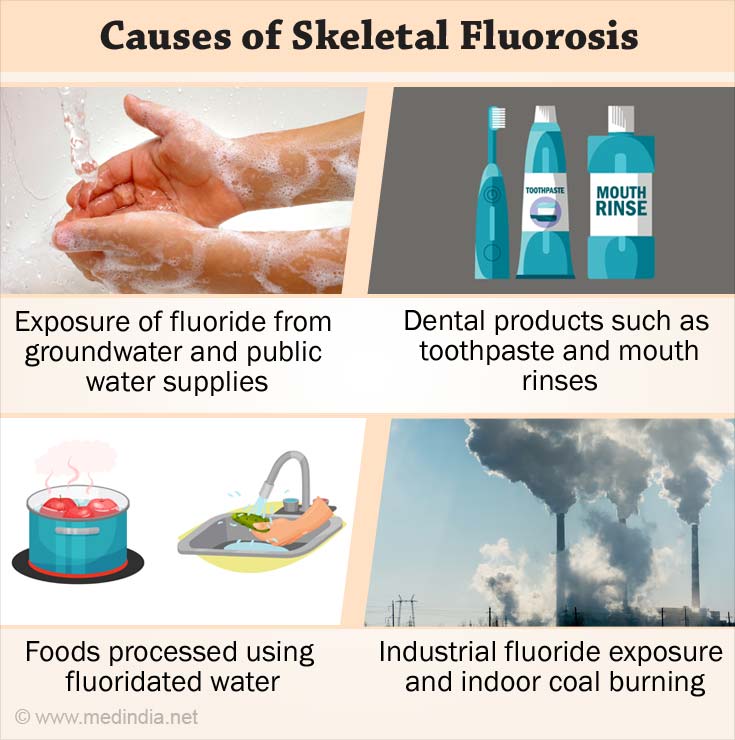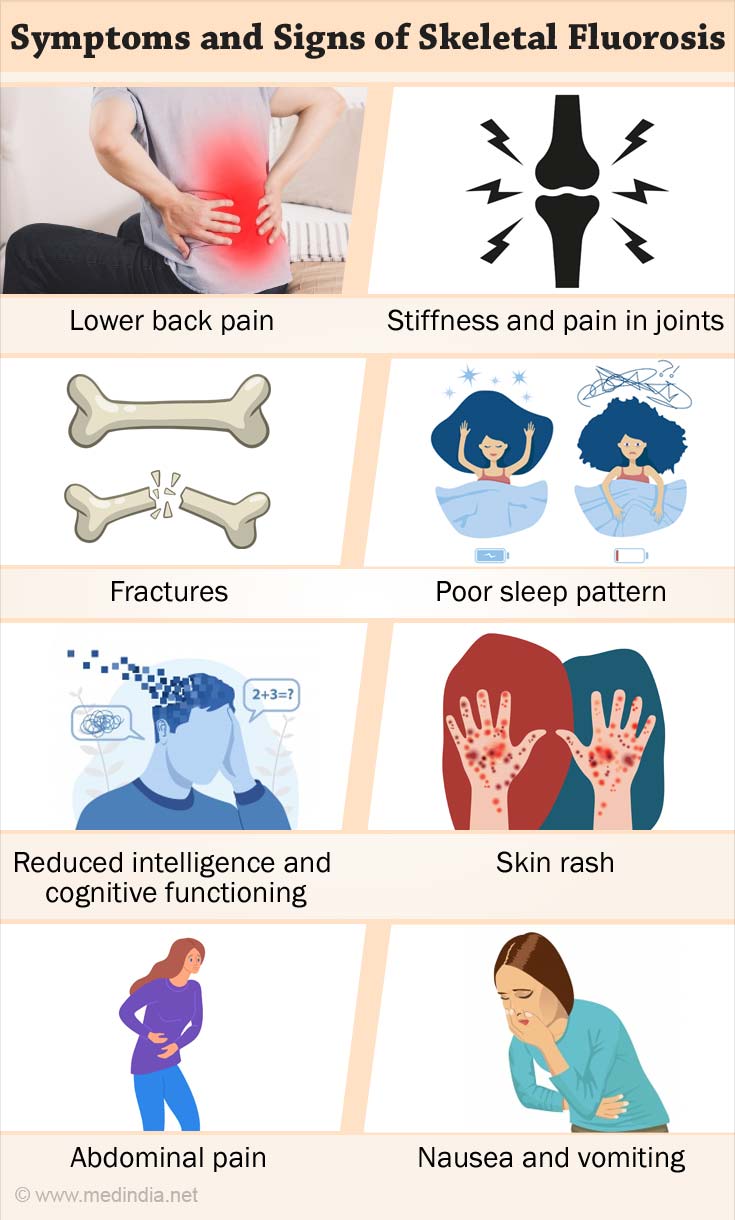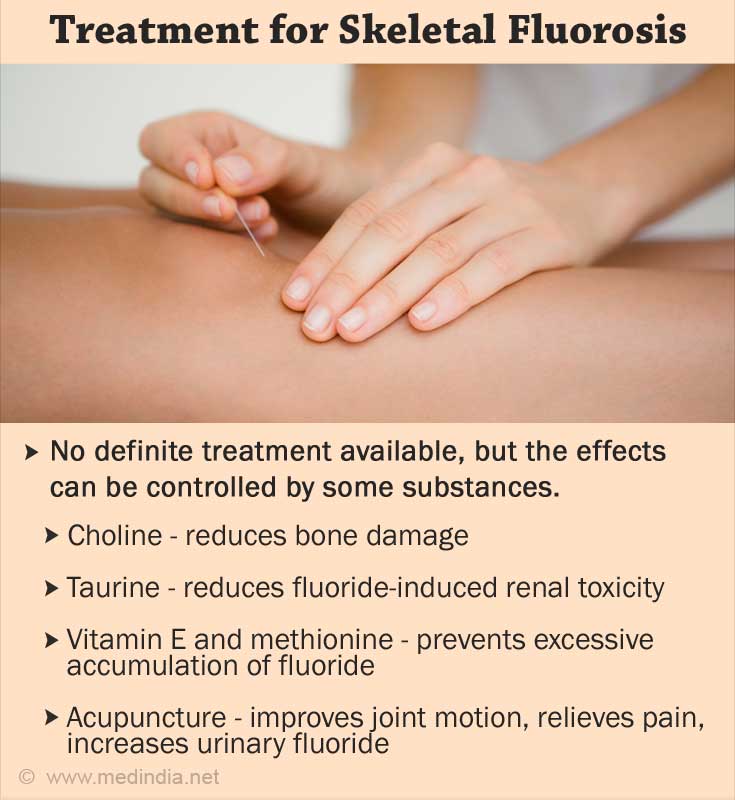- Skeletal Fluorosis - (https://fluoridealert.org/issues/health/skeletal_fluorosis/)
- Water-related diseases - Fluorosis - (https://www.who.int/teams/environment-climate-change-and-health/water-sanitation-and-health/burden-of-disease/other-diseases-and-risks/fluorosis)
- Fluorosis - Overview - (https://www.cdc.gov/fluoridation/faqs/dental_fluorosis/index.htm)
What is Skeletal Fluorosis?
Prolonged, excessive accumulation of fluoride can cause a debilitating bone and joint disease known as skeletal fluorosis. As an increased level of fluoride accumulates in the bones, it alters the bone metabolism, affecting the entire skeleton.
Due to the skeletal changes, bones become weaker and more brittle, while the pain and stiffness in joints increase. In most severe cases, joint immobility, muscle wasting, and neurological problems can lead to crippling.
Skeletal fluorosis is a preventable disease if it is distinguished from other bone and joint diseases at an early stage. It becomes hard to detect without knowing what to look for.
What are the Causes of Skeletal Fluorosis?
The total amount of ingested fluoride is the main factor that determines the development and progression of skeletal fluorosis.
Fluoride exposure from any source can lead to skeletal fluorosis. The common source is groundwater in some areas having dangerously high levels of fluoride. Hence, this disease is called endemic.
UNICEF estimates that fluorosis is endemic in at least 25 countries across the globe. Nineteen states in India have been identified as fluorosis endemic areas.

Other sources that contribute to developing skeletal fluorosis are -
- Fluoride is added to public water supplies in countries like the United States, the United Kingdom, and Australia. Even salt or milk is fluoridated in some countries.
- Dental products such as toothpaste and mouth rinses.
- Certain foods processed using fluoridated water or may absorb fluoride from the soil, such as old tea leaves, may contain fluoride in higher amounts than other foods.
- Industrial fluoride exposure and indoor coal burning.
What Does Fluoride do to the Bones?
Fluoride is a mineral found naturally in the water, soil, plants, rocks, and air. When it is ingested, it is absorbed into the blood through the digestive tract.
Approximately 50% of fluoride is removed through urinary excretion, and the rest of excessive fluoride is removed from blood circulation and gets accumulated in the bones.
This happens because fluoride’s negatively charged nature allows it to react with positively charged ions like calcium in bones.
Fluoride reacts with the calcium in bones to form calcium fluoride(CaF2). Through this process, fluoride replaces naturally occurring calcium hydroxyapatite in the bone to alter the normal bone formation and resorption.
When naturally occurring bone formation and resorption does not take place, it leads to several different bone disorders:
- Osteomalacia – softening of the bone due to inadequate bone mineralization.
- Osteoporosis– too little bone and/or too much bone loss makes bones weak and easy to break.
- Osteoarthritis is the most common form of arthritis that affects various joints in the body.
However, abnormal bone produced during the excessive accumulation of fluoride is not of good quality compared to bone made in healthy conditions and has increased density but decreased strength.
What are the Symptoms and Signs of Skeletal Fluorosis?
Generally, the greater the exposure to fluoride, the more severe are the symptoms. The most common early symptoms are lower back pain, stiffness and pain in joints, and fractures. These are also the red flag signs.
People who don’t experience the above symptoms can spot the development of skeletal fluorosis by observing earlier health effects caused by fluoride such as -

- Poor sleep pattern
- Reduced intelligence and cognitive functioning
- Skin rash, abdominal pain, nausea, and vomiting
- Staining and damage of teeth surface
In severe disease, there is a limitation of joint movement, muscle wasting, abnormal bending of the spine, and neurological defects due to compression of the spinal cord are seen.
In children, severe deformities in the spine, hip, and knee bones lead to crippling.
What are the Stages of Skeletal Fluorosis?
Individual progression through skeletal fluorosis may vary due to the complex nature of the disease.
The chart below provides guidelines on how skeletal fluorosis develops concerning bone fluoride concentrations.
|
Skeletal Fluorosis Stages |
Fluoride Concentration (mgF/kg) |
Symptoms and Signs |
|
Pre-Skeletal |
<3,500 |
No symptoms are seen. |
|
Pre-Clinical Stage |
3,500–5,000 |
Bone mass may increase with the start of early symptoms. |
|
Stage 1 |
6,000–7,000 |
Infrequent pain and stiffness in joints. |
|
Stage 2 |
7,500–9,000 |
Chronic joint pain with arthritis symptoms. |
|
Stage 3 |
8,400 |
Crippling skeletal fluorosis – mobility is significantly affected. |
How do you Diagnose Skeletal Fluorosis?
Many fail to understand the symptoms of skeletal fluorosis as it appears similar to other more well-known disease, bone and joint diseases.
Unfortunately, this leaves many undiagnosed until the advanced stage of crippling fluorosis, where it becomes impossible to cure.
Pinpoint diagnosis is hard and doctors should take into account an individual’s lifetime exposure to fluoride to diagnose skeletal fluorosis.
According to the NRC, in the absence of other sources of fluoride, the consumption of drinking water with a fluoride level of 1 ppm can reach 2,500 mg/kg in 12 years and 3,000 to 4,000 mg/kg of fluoride bone concentration over a long period.
Considering these factors, the US Environmental Protection Agency (EPA) has set a maximum amount of fluoride allowable in drinking water at 4.0 ppm.
High-Risk Factors of Skeletal Fluorosis
The extent of health effects caused by long-term fluoride toxicity depends on the following factors such as age, calcium intake, kidney function, sex, dose, and duration of fluoride intake.
Females having less bone mass, and children in the active stage of bone development are more vulnerable to fluoride toxicity than others.
Heavy tea consumption and impairment in kidney function are the other factors that play a role in the development of skeletal fluorosis.
Safe Fluoride Level
The current belief is that skeletal fluorosis does not occur at water fluoride levels below 4 ppm but studies performed in India and China have documented that skeletal fluorosis can occur at levels as low as 0.7 to 1.5 ppm of fluoride.
This shows that the same amount of fluoride can have different effects on different people. while someone with pre-skeletal fluorosis can experience painful symptoms, others with advanced skeletal fluorosis can remain symptom-free.
As fluoride serves no important function in human growth or development, it can be considered as a toxin and it is safe to tell that zero fluoride is a safe amount of fluoride.
How can you Treat Skeletal Fluorosis?
There is no particular treatment for skeletal fluorosis. The longer a person is exposed to fluoride, the more it accumulates and the harder it is to reverse the effects.
However, in recent studies following substances have been shown to control the health effects of skeletal fluorosis:

- Choline reduces damage to the internal bone structure by stopping the action of bone degrading enzymes in mice treated with fluoride.
- Vitamin E and methionine prevent excessive accumulation of fluoride in the bone by reducing its effect on soft tissues.
- Taurine reduces fluoride-induced renal toxicity.
- Acupuncture helps improve joint motion, relieves pain, and increases urinary fluoride.
- Health effects can be reversible in some cases, but it depends mainly on the disease progression.
How to Prevent Skeletal Fluorosis?
There are two ways to prevent skeletal fluorosis. The first and most important step is to eliminate the sources that expose you to excessive levels of fluoride. When fluoride intake is stopped, the amount of fluoride in the bones will decrease and it is excreted via urine.
The following steps will decrease the fluoride intake:
- Use a fluoride filter for your drinking water.
- Use fluoride-free toothpaste
- Limit tea consumption
- Avoid using teflon-coated non-stick cookware that contains fluoride in the form of PFCs (per-fluorinated compounds).

Secondly, remove all the fluoride accumulated in your body. To speed up this process, follow the methods that detox your body of fluoride. Those are:
- Eating a fluoride detox-friendly diet high in animal products, whole foods, and consuming foods that are grown organically in good quality soil.
- Exercising is one of the best ways to remove toxins from the body and it also helps stimulate good bone growth.
- Along with detox diet include foods rich in calcium, vitamin D, and vitamin C.
Avoiding the health effects of fluoride toxicity is eassy still millions of people suffer. This shows the lack of knowledge about skeletal fluorosis.









